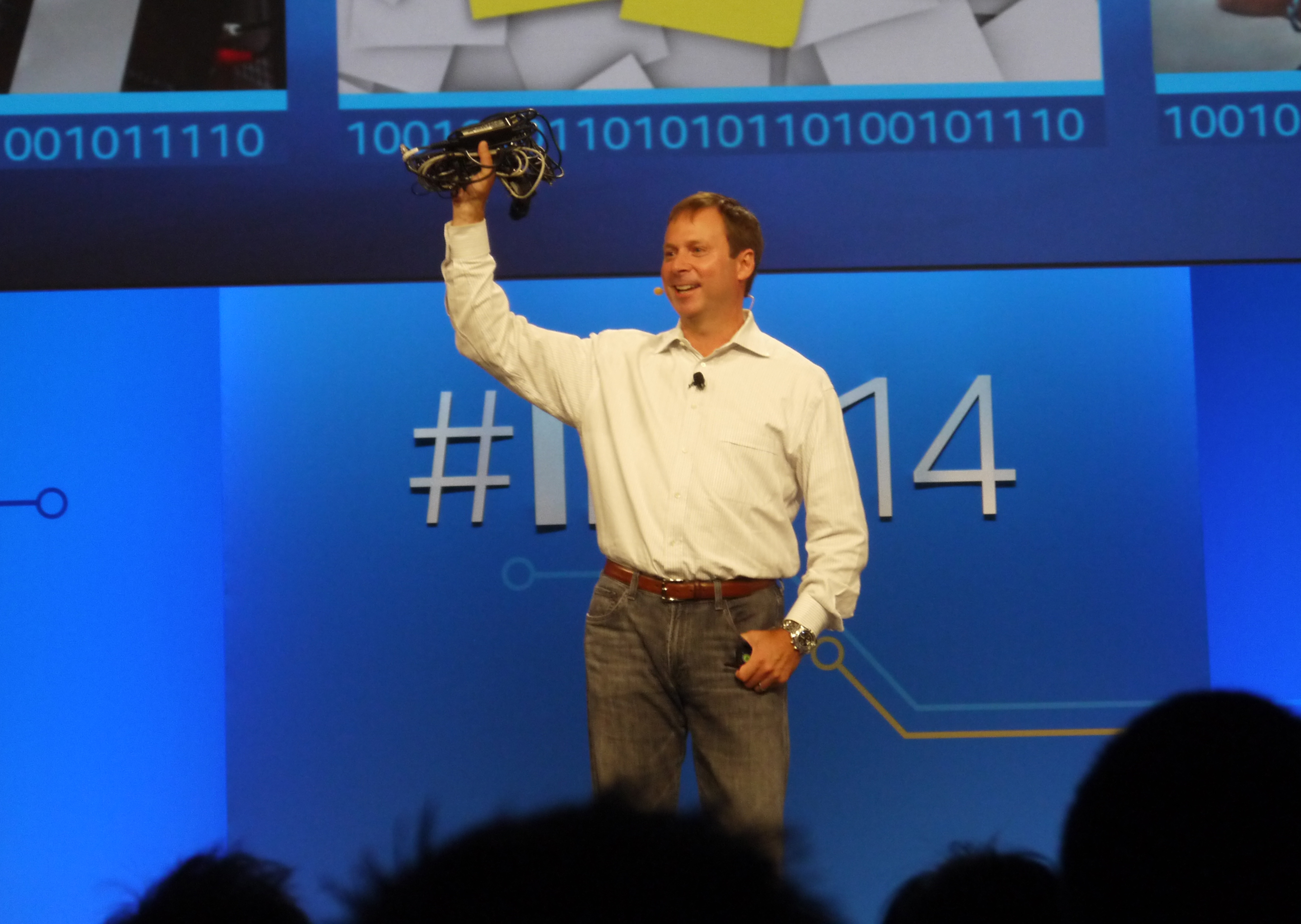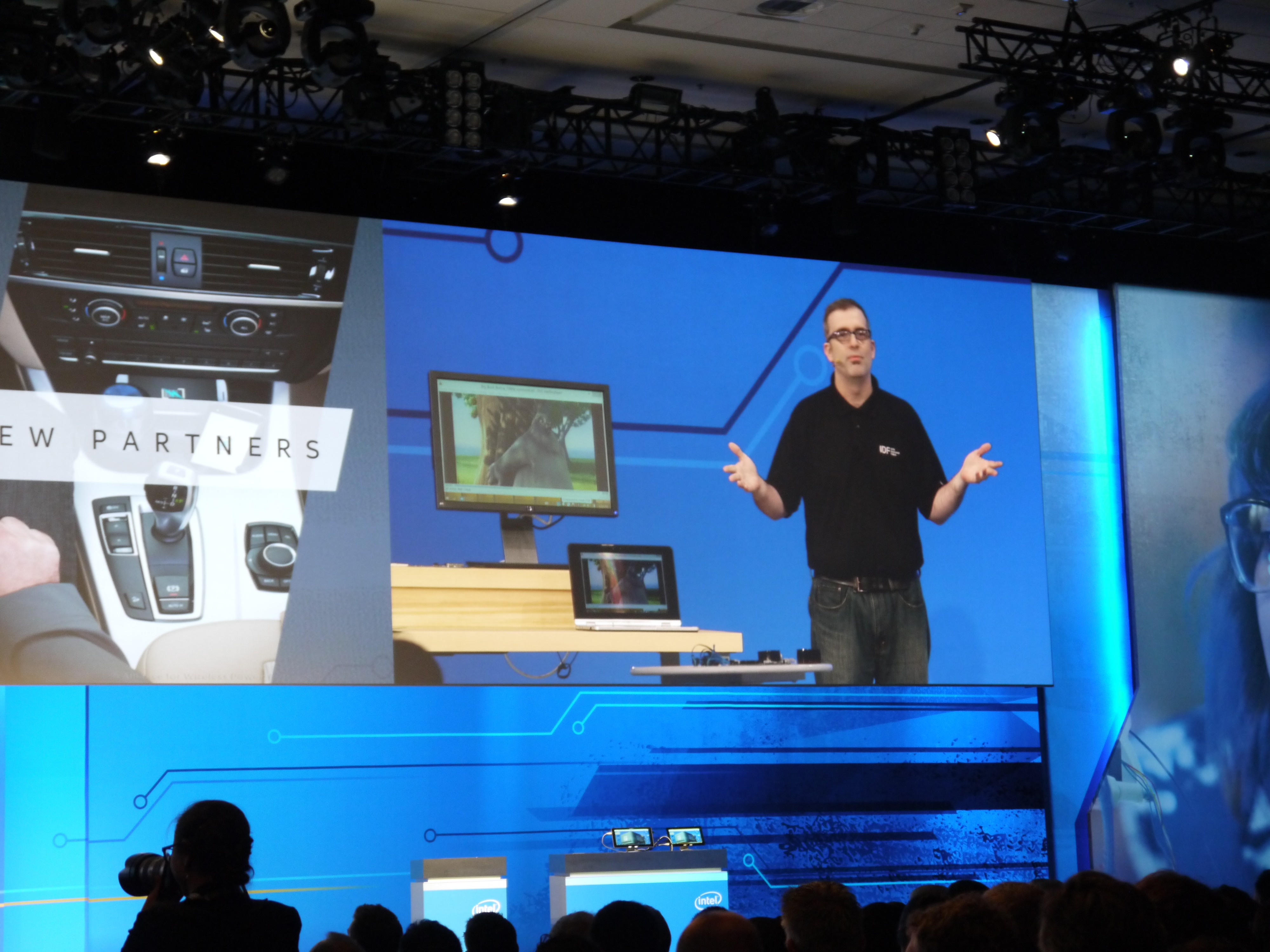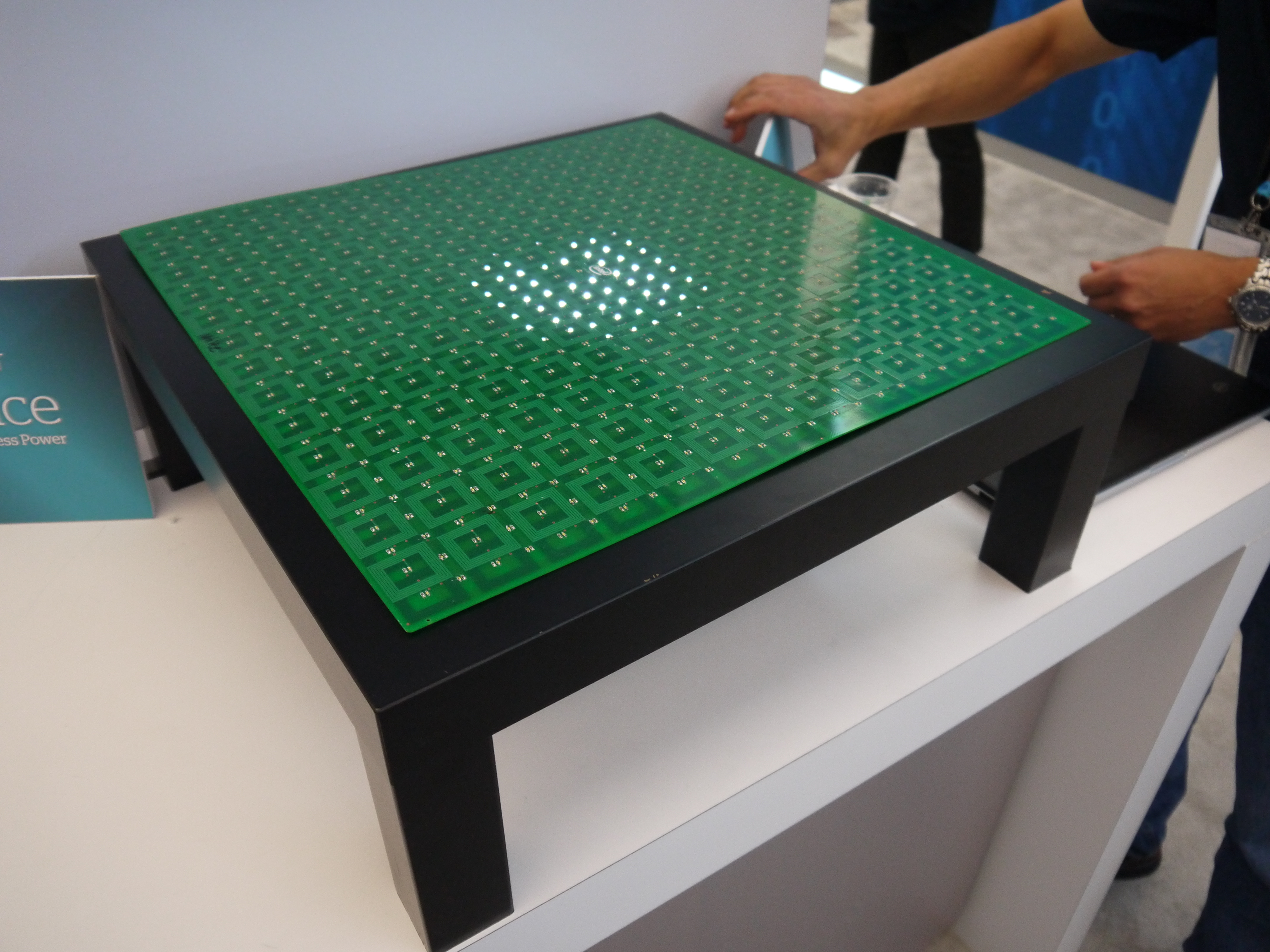Intel’s Wire Killers Demoed At IDF 2014: WiDi, WiGig And Rezence
We reported earlier that Intel wants to kill all cables, bringing wireless charging, data and more to the average PC. Despite Intel's bold claims on a short timeline for much of that technology (next year!), there's a ways to go before we see Rezence (wireless charging technology), WiGig (wireless peripherals connectivity) and WiDi (wireless display) become commonplace in our devices and everyday use; largely, that depends on Intel's many partners, who must make actual products using the tech.
In any case, we got an up-close look at both Rezence-powered wireless charging and 4K WiDi at IDF 2014.
WiDi
WiDi is nothing new; it's been around for a few years, but clearly Intel sees it as part of its larger wireless-everything strategy. WiDi uses the Miracast standard and can wirelessly stream HD content from one enabled device to another, such as from your laptop to a projector or large TV.
WiDi certainly has some promise, and it was striking to see it working on a massive 4K display, but we did notice that as the image on the screen changed, there were some artifacts that would appear briefly. It's not quite as easy to see on a video, but it's notable in person.
The artifacts aren't terribly distracting—it's akin to what you get sometimes when streaming video content, for example—but it's certainly a less appealing service than watching a DVD or Blu-ray.
Further, building 4K-capable WiDi in mobile PCs can be quite handy, because it allows you to use that PC as a hub for all your content, with no cables. By 2016, Intel expects that some 300 million devices will have WiDi capabilities baked in, and for those that don't, you'll be able to add WiDi with a small, inexpensive (about $40) dongle.
Intel is pushing both consumer-facing WiDi and a business-oriented version, WiDi Pro.
Get Tom's Hardware's best news and in-depth reviews, straight to your inbox.
WiGig
Despite the name (and its inclusion in the WiFi Alliance), WiGig (802.11ad) isn't really some speedy evolution of WiFi; instead, the technology promises to deliver wireless connectivity between your PC and its many peripherals. It's a dock, of sorts.
"Peripherals" in this case means essentially anything you'd attach to your PC – not just your mouse and keyboard, but your display and even storage, too. In Intel's WiGig demo onstage at IDF, we saw that a laptop automatically (and for all we could tell, quite seamlessly) connected with a display, mouse and keyboard.
WiGig purports to offer triple the speed of current WiFi and should see emergence in the market as early as the first half of 2015.
Rezence
We also got a look at wireless charging powered by Rezence. Although Rezence has been kicking around for a while now, the Alliance for Wireless Power (A4WP), the industry group developing the technology, launched its Global Certification Program in January, and thus the last several months have included a great deal of testing. Presumably, we'll soon see that work come to fruition in the form of Real Things.
The killer feature of Rezence is that, unlike some other wireless charging technologies such as Qi, you don't have to worry about orienting your device in a certain way in a certain space; as long as your device is in range, it will charge.
We weren't able to peek at the actual coils that do the work, but we were told that the demo we were looking at was capable of around 18 watts. (Theoretically, though, Rezence can handle up to 50 watts.) Do note that as you add devices to be charged, the wattage will be spread out among them all; thus, you can't stack five laptops and smartphones on there and expect them to juice up quickly.
Another premiere feature of Rezence is that it works through relatively thick materials. In the case of this demo, that's a 2-inch-thick wood desk, but we're told that it will work through even thicker materials, including metal.
What that means is that consumers could buy a wireless charging station of some kind (assuming an OEM makes one) and mount it under a coffee table, nightstand, your work desk or other spot where you might drop your smartphone, tablet or laptop.
Today, devices are not equipped with the "receiver" that can connect to a Rezence charging station, but that's changing soon. In a session this week, Kirk Skaugen held up a Samsung smartphone case that's equipped with the proper technology, and Intel believes that many devices will soon ship with those capabilities baked in.
(The laugh of the day was when the demonstrator, Rahim, had just finished saying that people had been putting their phones and laptops on the charging table all week expecting a charge, and he said that he was constantly explaining that their devices weren't equipped with the technology yet—and immediately, a fellow walked up, placed his phone on the table, and waited in vain.)
In order for Rezence to become something we see in widespread use, it needs strong adoption by OEMs and businesses looking to put wireless charging solutions in consumer products in stores and restaurants. It's reasonable to expect some movement there soon, though, as the A4WP counts among its members industry bigs such as Dell, Deutsche Telekom, HTC, Lenovo, LG, Qualcomm, Samsung, SanDisk, SK Telecom and dozens more.
For now, we'll enjoy the promise Rezence holds – and the neat light-up board Intel was using to show it off.
Follow Seth Colaner @SethColaner. Follow us @tomshardware, on Facebook and on Google+.
Seth Colaner previously served as News Director at Tom's Hardware. He covered technology news, focusing on keyboards, virtual reality, and wearables.
-
dgingeri I don't like or trust wireless technologies. They're inherently insecure. They can be hijacked by anyone. (WPS can be hacked in minutes, WPA takes a bit longer, but not by that much. I've had my wireless network hacked numerous times because of WPS.) Adding security measures makes it harder to work with, so many people of the general public object to the security necessary to have decent wireless technologies. (Thus the problems with WPS.) On top of that, they get interference from many sources and disconnect or work slowly. Wireless charging is ok, and I could live with that, but wireless networking is a pain in the behind. The only reason I have it is to run my tablet. I've got it isolated from my main network because it is so insecure. Wireless Display looks like a horrible ides that would be horrible to support.Reply -
WithoutWeakness ReplyI don't like or trust wireless technologies. They're inherently insecure. They can be hijacked by anyone. (WPS can be hacked in minutes, WPA takes a bit longer, but not by that much. I've had my wireless network hacked numerous times because of WPS.) Adding security measures makes it harder to work with, so many people of the general public object to the security necessary to have decent wireless technologies. (Thus the problems with WPS.) On top of that, they get interference from many sources and disconnect or work slowly. Wireless charging is ok, and I could live with that, but wireless networking is a pain in the behind. The only reason I have it is to run my tablet. I've got it isolated from my main network because it is so insecure. Wireless Display looks like a horrible ides that would be horrible to support.
WPA2 + AES is far more secure and should be the standard for any wireless network being set up today. Cracking WPA2 + AES would take an absurdly long time (many months if not years) and would require some serious hardware to complete the task. WPS should absolutely be disabled as it doesn't make connecting devices any easier and is a security nightmare.
802.11ac devices are much faster and less susceptible to interference than older 802.11g and even 802.11n equipment. Wired ethernet is still king for reliability and throughput but not everyone can or wants to run ethernet cables to the locations of all of their devices. Newer standards and equipment have come a long way in the past few years. -
f-14 Replyto put wireless charging solutions in consumer products in stores and restaurants.
no store or restaurants are going to want to add expenses of these fool tools and increased power bills when they are squeezing every penny already.
this would be better implemented at kiddie schools where kids have no concept of charging devices or can't be trusted not to put sockets or plug-ins in their mouths. it would be great for hospitals and business where there isn't time nor outlets to deal with cords and their clutter.
as far as wireless information transmission the NSA/law enforcement is going to love this, more free access to everything, no court order required. same with competing companies and foreign governments spy agencies. -
dgingeri Reply14181068 said:WPA2 + AES is far more secure and should be the standard for any wireless network being set up today. Cracking WPA2 + AES would take an absurdly long time (many months if not years) and would require some serious hardware to complete the task. WPS should absolutely be disabled as it doesn't make connecting devices any easier and is a security nightmare.
802.11ac devices are much faster and less susceptible to interference than older 802.11g and even 802.11n equipment. Wired ethernet is still king for reliability and throughput but not everyone can or wants to run ethernet cables to the locations of all of their devices. Newer standards and equipment have come a long way in the past few years.
1. WPA2 is fairly easy to crack with either a monitoring log, where the encryption keys are exchanged every two hours or through using a GPU to decrypt the data. Since WPA reconnects and exchanges keys so often, just monitoring the data at the right time will allow a listener to get the keys and get in. GPU decryption has made decrypting data where you don't have they key far quicker. With a 4 or 6 core CPU, it would take years to decrypt, but with a GPU with 1536 simple processors, it comes down to hours.
2. WPS is found on all consumer level routers and access point on both Wireless N and AC. In order to get a wireless access point without WPS, a person has to spend about ten times as much for a commercial router. What's more is that while is can be "disabled" on most routers, they all keep the code active, and a hacker can still get in using the PIN. It takes getting an open source router and putting on a special version of the firmware that completely disables the WPS code to actually turn it off. It's horrible.
3. I have a dual band Wireless N router in my bedroom with 6 antennas. Not ten feet away, in the same room, I have two tablets and two phones that use both bands. My work iPhone and my android tablet use the 2.4GHz band, while my Windows phone and Windows RT tablet use the 5GHz band. None of them can connect at higher than 60Mb, and all of them have problems disconnecting when I walk out of the room. I have tried tuning the router channels in several suggested ways, and the power of the router is at maximum. Yet, I still can't get it higher than 60Mb, and they still like to disconnect. I have turned it off on my personal phone specifically because of the disconnection problems. The big reason behind it all is that I live in an apartment complex with several hundred other people. I can see over 100 wireless networks from my tablet at any given time. So, we're basically all stomping on each others' feet, wirelessly. I will always prefer wired networks. I never get this type of problem from a wired network. -
WithoutWeakness Reply
I think wireless charging will be a more widespread standard in a few years, especially if Apple hops on board the wireless charging train. If the next generation of iPhones and iPads support wireless charging then there will be several manufacturers adopting whatever standard they choose (unless it's some proprietary nonsense). Starbucks, McCafe, and other similar chains will then start installing these wireless charging grids under their tables and counters and people will just put their phones on the table and top off the batteries as they sip their lattes. When the time comes that wireless charging is standard in new devices a manufacturer of these charging pads will pair up with the restaurants and start subsidizing the cost of the charging pads and installation. The cost will be very low for restaurants and the benefit to customers will be easy to sell.14181598 said:to put wireless charging solutions in consumer products in stores and restaurants.
no store or restaurants are going to want to add expenses of these fool tools and increased power bills when they are squeezing every penny already.
this would be better implemented at kiddie schools where kids have no concept of charging devices or can't be trusted not to put sockets or plug-ins in their mouths. it would be great for hospitals and business where there isn't time nor outlets to deal with cords and their clutter.
as far as wireless information transmission the NSA/law enforcement is going to love this, more free access to everything, no court order required. same with competing companies and foreign governments spy agencies. -
coolitic I would imagine that wireless peripherals would have short range signals, with each device on different frequencies.Reply -
quotas47 WiGig is not viable in locations with user density above 5-10.Reply
Heard this right from Dell.
No switch or automatic hopping on device to diversify frequencies.
Terrible for cube farms.



